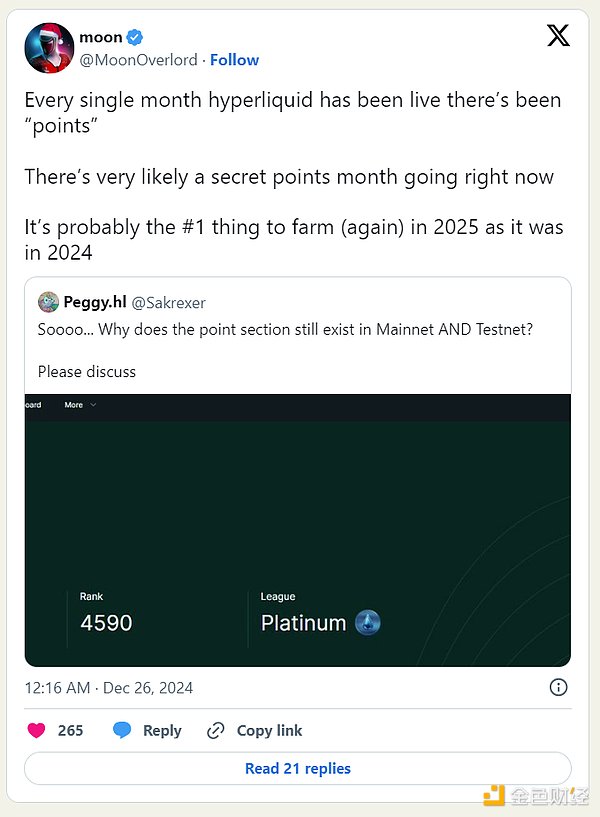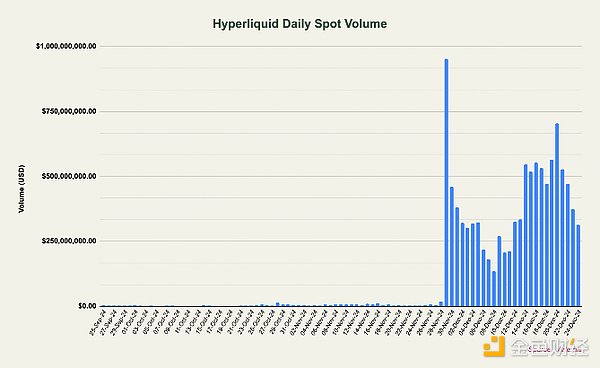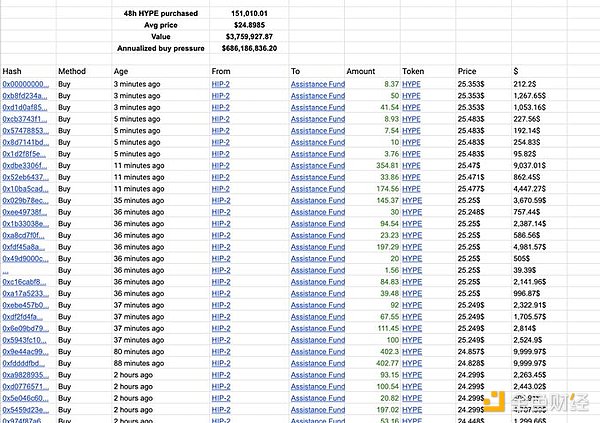Author: Thor Hartvigsen, Crypto Researcher at On Chain Times; Translation: Jinse Finance xiaozou
1, Preface
Since the launch of HYPE, Hyperliquid has achieved tremendous growth in both trading volume and revenue. HYPE was launched on November 29 at a price of $2 and rose by more than 1,400% in less than a month. This article will delve into the fundamentals of Hyperliquid and HYPE, explore the bullish case for HYPE, and its potential valuation in 2025 with the growth of trading volume and revenue.
2、Trading Volume
Before HYPE was released, skeptics expected low trading volume after the airdrop, as past behavior of perpetual decentralized exchanges showed just that… Greedy capital will move from the highest reward protocol to the next highest reward protocol. It is worth noting that since the release of HYPE, Hyperliquid's trading volume has increased dramatically, reaching a single-day high of more than $10 billion in just one day. In addition to the large number of incentives given to traders before, Hyperliquid is a high-quality on-chain product that most traders who use the platform will recognize.
It is also worth noting that while the first wave of airdrops accounted for 31% of HYPE's supply, an estimated 42.81% of the total supply will be used for future token distribution and community rewards. While it is expected that some of these rewards are specifically for staking incentives and potential bounties centered around the HyperEVM L1 ecosystem, it is not impossible that current trading volume and/or HYPE holders are receiving some kind of reward without knowing it.

42.81% of HYPE supply is roughly equivalent to $11 billion (at a price of $25 per HYPE), which is a significant return and makes Hyperliquid trading more attractive to perpetual contract traders. However, it is important to note that this is purely speculation.

(1)Hyperliquid vs CEXs(Centralized Exchanges)
We have been tracking the trading volume of Hyperliquid relative to centralized exchanges like Binance for a long time. Over time, as more and more users and trading volume move to the chain, Hyperliquid's market share will continue to grow. Comparing Hyperliquid to Binance, it is clear that Hyperliquid still has a long way to go. However, in December, Hyperliquid's market share showed a clear upward trend, as shown in the figure below. In the past two weeks, Hyperliquid's relative market share has remained around 5-8%. According to Coingecko data, Binance's recent daily derivatives trading volume is between $60 billion and $150 billion. But because there is no way to actually verify these trading volume data from centralized exchanges, you may need to take these data with a grain of salt.

(2)Spot Trading Volume
As you may already know, Hyperliquid also has a spot token market. Hyperliquid also has a spot token market. Since the launch of HYPE, spot trading volume has increased significantly, and the most traded tokens are HYPE, PURR, HFUN, and PIP.

Tokens are added to the Hyperliquid spot market through an auction, where the highest bidder can publish their ticker. This happens every 31 hours and currently sells for about $300,000, as shown in the figure below. The highest auction price was GOD on December 16, where bidders paid nearly $1 million.

3, Fees and Yield
(1)Perps(Perpetual Trading)
Hyperliquid's fees are paid by traders on the platform. Compared to other exchanges such as Binance, fees are kept low to incentivize trading activity. For perpetual futures trading, for most people, the fees for market orders (taker) are 0.035% and limit orders (maker) are 0.01%. The more you do, the lower your fees will be.

In order to calculate the fees charged by the protocol, the average fee paid by traders must be calculated (taker vs maker volume and average fee tier). ASXN did a good analysis of this in their September report, as shown in the figure below. From this, the average fee paid is estimated to be 0.01276%, which is a conservative/worst case scenario as market maker rebates are assumed.

Given this average fee value, if Hyperliquid’s perpetual futures daily volume averages $5 billion to $10 billion, that translates to annual fees of $232,870,000 to $465,740,000 (in reality, actual fees are likely higher due to conservative assumptions about average fees).
These fees are collected by the HLP market making treasury, insurance fund, assistance fund, and a number of other miscellaneous addresses on Hyperliquid. The team does not disclose information about the exact distribution of revenue generated from fees from trading activity on the platform, making it difficult to accurately estimate HYPE buybacks.
(2)Spot (Spot Trading)
The fees paid by traders on the spot market are used to purchase and burn the tokens traded. Unsurprisingly, HYPE accounts for the majority of spot trading volume on Hyperliquid. To date, over 100,000 HYPE ($2.5 million at current prices) has been burned from HYPE's spot fees. From a macro perspective, this has no material impact on the supply of HYPE compared to the buyback from the assistance fund (at least not yet).

(3)Spot Auction
Hyperliquid can also earn significant revenue from the funds paid by the winning bidders of the spot auction. At $300,000 per auction, Hyperliquid's annual revenue will increase by $84,774,000. Flo published a great analysis on X, covering Hyperliquid's revenue under different scenarios of spot auction prices and daily trading volume. At $1 million per spot auction and $6 billion in daily trading volume, Hyperliquid's estimated annual revenue is $829.5 million. At a 30x P/E (price-to-earnings ratio), this would put HYPE at $74.52 per token.

4、Assistance Fund and HYPERepurchase
Although it is not yet certain how the income from spot auctions and perpetual transactions is distributed between the Assistance Fund (AF), Insurance Fund, HLP and other addresses, we can measure the daily repurchase of HYPE through the Assistance Fund. A few days ago, I published an analysis article on X, analyzing the 48-hour HYPE repurchase of the Assistance Fund. The situation at the time was that 151,000 HYPE were repurchased within 48 hours, equivalent to an annualized purchase pressure of US$686 million. In the past two days, Hyperliquid's average daily trading volume has reached 8 billion US dollars.

Compared with many other crypto protocols, HYPE directly derives value from the revenue generated by Hyperliquid.
5Future Outlook
Going into 2025, the bullish HYPE is a bet on the growing trading volume on the Hyperliquid exchange and the growing demand for spot auctions, which will lead to increased revenue and, in turn, larger HYPE buybacks. One reason Hyperliquid will be used by more and more people is that it also reserves billions of dollars in future bonuses, which makes Hyperliquid a very profitable trading place. Hyperliquid has a very strong user-centric community, and a lot of thought sharing and strong narratives have been formed around the protocol and HYPE.
With the emergence of new features such as staking, perpetual trading token margin, and the application ecosystem brought by HyperEVM, there will be a lot of potential positive factors and a lot to look forward to.
 JinseFinance
JinseFinance
 JinseFinance
JinseFinance JinseFinance
JinseFinance JinseFinance
JinseFinance Bernice
Bernice cryptopotato
cryptopotato cryptopotato
cryptopotato Others
Others Bitcoinist
Bitcoinist Bitcoinist
Bitcoinist